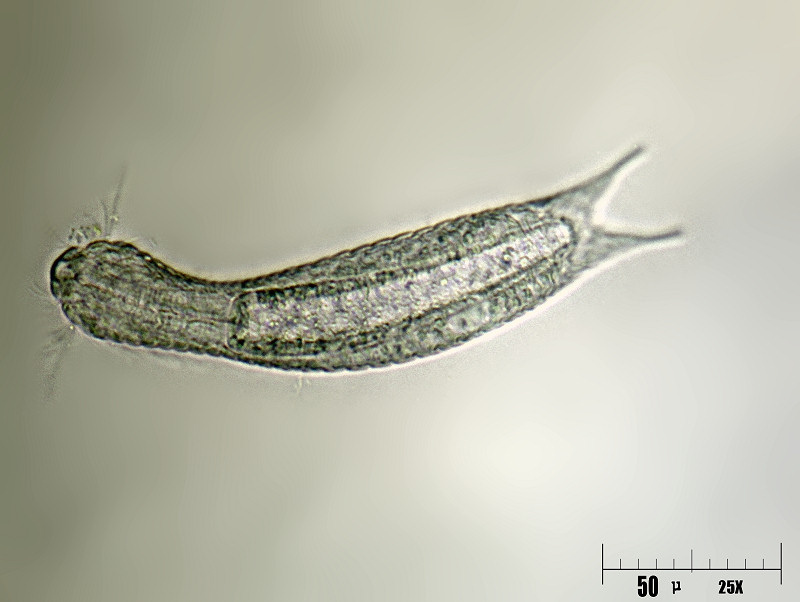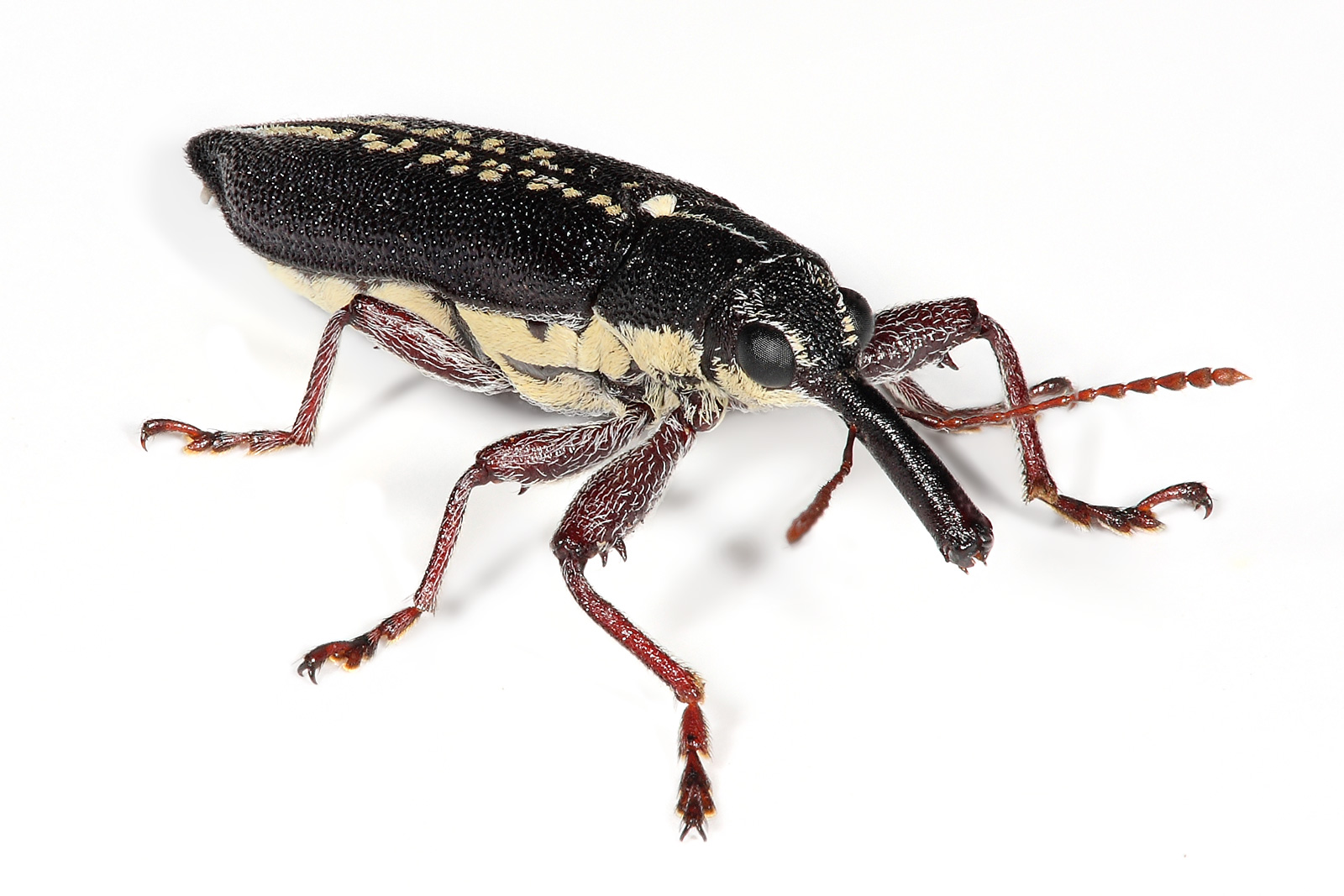|
Gastrotricha
The gastrotrichs (phylum Gastrotricha), commonly referred to as hairybellies or hairybacks, are a group of microscopic (0.06-3.0 mm), worm-like, acoelomate animals, and are widely distributed and abundant in freshwater and marine environments. They are mostly benthic and live within the periphyton, the layer of tiny organisms and detritus that is found on the seabed and the beds of other water bodies. The majority live on and between particles of sediment or on other submerged surfaces, but a few species are terrestrial and live on land in the film of water surrounding grains of soil. Gastrotrichs are divided into two orders, the Macrodasyida which are marine (except for two species), and the Chaetonotida, some of which are marine and some freshwater. Nearly 800 species of gastrotrich have been described. Gastrotrichs have a simple body plan with a head region, with a brain and sensory organs, and a trunk with a simple gut and the reproductive organs. They have adhesive g ... [...More Info...] [...Related Items...] OR: [Wikipedia] [Google] [Baidu] |
Flatworm
The flatworms, flat worms, Platyhelminthes, or platyhelminths (from the Greek πλατύ, ''platy'', meaning "flat" and ἕλμινς (root: ἑλμινθ-), ''helminth-'', meaning "worm") are a phylum of relatively simple bilaterian, unsegmented, soft-bodied invertebrates. Unlike other bilaterians, they are acoelomates (having no body cavity), and have no specialized circulatory and respiratory organs, which restricts them to having flattened shapes that allow oxygen and nutrients to pass through their bodies by diffusion. The digestive cavity has only one opening for both ingestion (intake of nutrients) and egestion (removal of undigested wastes); as a result, the food cannot be processed continuously. In traditional medicinal texts, Platyhelminthes are divided into Turbellaria, which are mostly non- parasitic animals such as planarians, and three entirely parasitic groups: Cestoda, Trematoda and Monogenea; however, since the turbellarians have since been proven no ... [...More Info...] [...Related Items...] OR: [Wikipedia] [Google] [Baidu] |
Acoelomate
The coelom (or celom) is the main body cavity in most animals and is positioned inside the body to surround and contain the digestive tract and other organs. In some animals, it is lined with mesothelium. In other animals, such as molluscs, it remains undifferentiated. In the past, and for practical purposes, coelom characteristics have been used to classify bilaterian animal phyla into informal groups. Etymology The term ''coelom'' derives from the Ancient Greek word (), meaning 'cavity'. Structure Development The coelom is the mesodermally lined cavity between the gut and the outer body wall. During the development of the embryo, coelom formation begins in the gastrulation stage. The developing digestive tube of an embryo forms as a blind pouch called the archenteron. In Protostomes, the coelom forms by a process known as schizocoely. The archenteron initially forms, and the mesoderm splits into two layers: the first attaches to the body wall or ectoderm, for ... [...More Info...] [...Related Items...] OR: [Wikipedia] [Google] [Baidu] |
Lophotrochozoa
Lophotrochozoa (, "crest/wheel animals") is a clade of protostome animals within the Spiralia. The taxon was established as a monophyletic group based on molecular evidence. The clade includes animals like annelids, molluscs, bryozoans, brachiopods, and platyhelminthes. Groups Lophotrochozoa was defined in 1995 as the "last common ancestor of the three traditional lophophorate taxa ( brachiopods, bryozoans, and phoronid worms), the mollusks and the annelids, and all of the descendants of that common ancestor". It is a cladistic definition (a node-based name), so the affiliation to Lophotrochozoa of spiralian groups not mentioned directly in the definition depends on the topology of the spiralian tree of life, and in some phylogenetic hypotheses, Lophotrochozoa may even be synonymous to Spiralia. Nemertea and Orthonectida (if not directly considered as part of Annelida) are probably lophotrochozoan phyla; Dicyemida, Gastrotricha, and Platyhelminthes may be lophot ... [...More Info...] [...Related Items...] OR: [Wikipedia] [Google] [Baidu] |
Macrodasyida
Macrodasyida is an order of gastrotrichs. Members of this order are somewhat worm-like in form, and not more than 1 to 1.5 mm in length. Macrodasyids are almost in entirely marine and live in the sediment in marine or brackish water, but two species have been discovered in freshwater. They can be distinguished from other gastrotrichs by the presence of two pores on either side of the pharynx, that allow excess water to be expelled during feeding. The body is dorsally flattened and there are tubular adhesive glands at both ends and on the lateral surfaces. These animals are detritivores and are hermaphrodites. Families *Cephalodasyidae Hummon & Todaro, 2010 *Dactylopodolidae Strand, 1929 * Hummondasyidae Todaro, Leasi & Hochberg, 2014 *Lepidodasyidae Remane, 1927 *Macrodasyidae Remane, 1924 *Planodasyidae Rao & Clausen, 1970 *Redudasyidae Todaro, Dal Zotto, Jondelius, Hochberg, Hummon, Kanneby & Rocha, 2012 *Thaumastodermatidae Remane, 1927 *Turbanellidae Remane, 1926 *Xenod ... [...More Info...] [...Related Items...] OR: [Wikipedia] [Google] [Baidu] |
Nematode
The nematodes ( or grc-gre, Νηματώδη; la, Nematoda) or roundworms constitute the phylum Nematoda (also called Nemathelminthes), with plant- parasitic nematodes also known as eelworms. They are a diverse animal phylum inhabiting a broad range of environments. Less formally, they are categorized as Helminths, but are taxonomically classified along with arthropods, tardigrades and other moulting animals in the clade Ecdysozoa, and unlike flatworms, have tubular digestive systems with openings at both ends. Like tardigrades, they have a reduced number of Hox genes, but their sister phylum Nematomorpha has kept the ancestral protostome Hox genotype, which shows that the reduction has occurred within the nematode phylum. Nematode species can be difficult to distinguish from one another. Consequently, estimates of the number of nematode species described to date vary by author and may change rapidly over time. A 2013 survey of animal biodiversity published in the mega ... [...More Info...] [...Related Items...] OR: [Wikipedia] [Google] [Baidu] |
Gnathostomulid
Gnathostomulids, or jaw worms, are a small phylum of nearly microscopic marine animals. They inhabit sand and mud beneath shallow coastal waters and can survive in relatively anoxic environments. They were first recognised and described in 1956. Anatomy Most gnathostomulids measure in length. They are often slender to thread-like worms, with a generally transparent body. In many Bursovaginoidea, one of the major group of gnathostomulids, the neck region is slightly narrower than the rest of the body, giving them a distinct head. Like flatworms they have a ciliated epidermis, but in contrast to flatworms, they have one cilium per cell. The cilia allow the worms to glide along in the water between sand grains, although they also use muscles, allowing the body to twist or contract, for movement. They have no body cavity, and no circulatory or respiratory system. The nervous system is simple, and restricted to the outer layers of the body wall. The only sense organs are modifi ... [...More Info...] [...Related Items...] OR: [Wikipedia] [Google] [Baidu] |
Chaetonotida
The Chaetonotida is an order of gastrotrichs. They generally have a tenpin or bottle-like shape. Chaetonotids inhabit both freshwater and marine environments. They can be distinguished from other gastrotrichs by the absence of pores in the pharynx, and by the presence of adhesive glands at the posterior end of the animal only. Most freshwater species are parthenogenetic Parthenogenesis (; from the Greek grc, παρθένος, translit=parthénos, lit=virgin, label=none + grc, γένεσις, translit=génesis, lit=creation, label=none) is a natural form of asexual reproduction in which growth and developmen .... The smooth or complex cuticle has a variable number of adhesive tubes, and the pharyngeal lumen of Chaetonotids is Y-shaped. A valve may be present at the junction of the pharynx and midgut. The epidermis in most organisms in this order is partly syncytial. The Chaetonotids are divided into two suborders, Multitubulatina and Paucitubulatina. Multitubulatina are ... [...More Info...] [...Related Items...] OR: [Wikipedia] [Google] [Baidu] |
Phylum
In biology, a phylum (; plural: phyla) is a level of classification or taxonomic rank below kingdom and above class. Traditionally, in botany the term division has been used instead of phylum, although the International Code of Nomenclature for algae, fungi, and plants accepts the terms as equivalent. Depending on definitions, the animal kingdom Animalia contains about 31 phyla, the plant kingdom Plantae contains about 14 phyla, and the fungus kingdom Fungi contains about 8 phyla. Current research in phylogenetics is uncovering the relationships between phyla, which are contained in larger clades, like Ecdysozoa and Embryophyta. General description The term phylum was coined in 1866 by Ernst Haeckel from the Greek (, "race, stock"), related to (, "tribe, clan"). Haeckel noted that species constantly evolved into new species that seemed to retain few consistent features among themselves and therefore few features that distinguished them as a group ("a self-contain ... [...More Info...] [...Related Items...] OR: [Wikipedia] [Google] [Baidu] |
Marine (ocean)
The ocean (also the sea or the world ocean) is the body of salt water that covers approximately 70.8% of the surface of Earth and contains 97% of Earth's water. An ocean can also refer to any of the large bodies of water into which the world ocean is conventionally divided."Ocean." ''Merriam-Webster.com Dictionary'', Merriam-Webster, [...More Info...] [...Related Items...] OR: [Wikipedia] [Google] [Baidu] |
Parthenogenesis
Parthenogenesis (; from the Greek grc, παρθένος, translit=parthénos, lit=virgin, label=none + grc, γένεσις, translit=génesis, lit=creation, label=none) is a natural form of asexual reproduction in which growth and development of embryos occur in a gamete (egg or sperm) without combining with another gamete (e.g., egg and sperm fusing). In animals, parthenogenesis means development of an embryo from an unfertilized egg cell. In plants, parthenogenesis is a component process of apomixis. In algae, parthenogenesis can mean the development of an embryo from either an individual sperm or an individual egg. Parthenogenesis occurs naturally in some plants, algae, invertebrate animal species (including nematodes, some tardigrades, water fleas, some scorpions, aphids, some mites, some bees, some Phasmatodea and parasitic wasps) and a few vertebrates (such as some fish, amphibians, reptiles and birds). This type of reproduction has been induced artificiall ... [...More Info...] [...Related Items...] OR: [Wikipedia] [Google] [Baidu] |
Ecdysozoa
Ecdysozoa () is a group of protostome animals, including Arthropoda (insects, chelicerata, crustaceans, and myriapods), Nematoda, and several smaller phyla. They were first defined by Aguinaldo ''et al.'' in 1997, based mainly on phylogenetic trees constructed using 18S ribosomal RNA genes. A large study in 2008 by Dunn ''et al.'' strongly supported the Ecdysozoa as a clade, that is, a group consisting of a common ancestor and all its descendants. The group is also supported by morphological characters, and includes all animals that grow by ecdysis, moulting their cuticle. The group was initially contested by a significant minority of biologists. Some argued for groupings based on more traditional taxonomic techniques, while others contested the interpretation of the molecular data. Etymology The name ''Ecdysozoa'' stems etymologically . Characteristics The most notable characteristic shared by ecdysozoans is a three-layered cuticle (four in Tardigrada) composed ... [...More Info...] [...Related Items...] OR: [Wikipedia] [Google] [Baidu] |
Phylogenetics
In biology, phylogenetics (; from Greek φυλή/ φῦλον [] "tribe, clan, race", and wikt:γενετικός, γενετικός [] "origin, source, birth") is the study of the evolutionary history and relationships among or within groups of organisms. These relationships are determined by Computational phylogenetics, phylogenetic inference methods that focus on observed heritable traits, such as DNA sequences, protein amino acid sequences, or morphology. The result of such an analysis is a phylogenetic tree—a diagram containing a hypothesis of relationships that reflects the evolutionary history of a group of organisms. The tips of a phylogenetic tree can be living taxa or fossils, and represent the "end" or the present time in an evolutionary lineage. A phylogenetic diagram can be rooted or unrooted. A rooted tree diagram indicates the hypothetical common ancestor of the tree. An unrooted tree diagram (a network) makes no assumption about the ancestral line, and doe ... [...More Info...] [...Related Items...] OR: [Wikipedia] [Google] [Baidu] |






